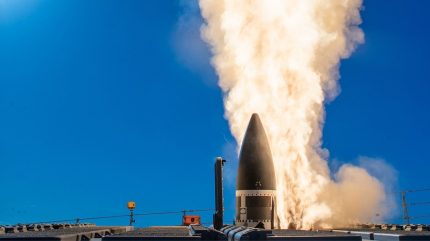
Raytheon, a subsidiary of the US defence industrial prime RTX, has reached full-rate production of the latest Standard Missile 3 (SM-3) iteration, Block IIA.
Now that manufacturing capacity is operating fully at the company’s facilities in Tucson, Arizona and Huntsville, Alabama, the US Missile Defense Agency (MDA) has allocated nearly $2bn for the acquisition of the new generation ballistic missile interceptors in July 2024.

Discover B2B Marketing That Performs
Combine business intelligence and editorial excellence to reach engaged professionals across 36 leading media platforms.
This work will take place over the next seven years; the company stated that production will conclude on 28 February 2031.
Naval Technology contacted the prime for more details regarding the level of capacity and the number of units anticipated per year. However, Raytheon commented:
“Full-rate production is not necessarily an indication of a change in delivered or produced quantities but rather a sign of programme maturity and stability.
“It signals that there is no elevated design or manufacturing risk in the missile and validates its reliability and performance. Full maturity means the missile has cleared the development phase.”

US Tariffs are shifting - will you react or anticipate?
Don’t let policy changes catch you off guard. Stay proactive with real-time data and expert analysis.
By GlobalDataNevertheless, the “SM-3 Block IIA is a testament to the continuing partnership with Japanese industry to mature ballistic missile defence capabilities for the defence of our nation and our allies around the globe,” remarked Barbara Borgonovi, president of Naval Power at Raytheon.
US-Japan endeavour
SM-3 Block IIA was designed in cooperation with Japan; the first unit was tested in 2017. This latest iteration contrasts with the US-produced Block IB variant, which was first launched from an Aegis Ashore testing site in 2014.
Notably, the US is in the middle of kitting out the Japanese Maritime Self-Defense Force with two guided missile destroyers enabled by Aegis Ballistic Missile Defence – an integrated network of sensors, interceptors and command & control.
Japan is in the process of procuring the SM-3 Block IIA as its interceptor given it is a fellow industrial partner in the programme. Previously, the Japanese government committed $308.4m (Y47.5bn) in Foreign Military Sale funds in July as part of the total $2bn sum.
The interceptor
The new interceptor has two distinct new features: larger rocket motors that enable the system to defend broader areas from ballistic missile threats and a larger kinetic warhead.
Likewise, the kinetic warhead – which destroys a target with sheer force rather than an explosive weapon – has been enhanced, improving the search, discrimination, acquisition and tracking functions, to address advanced and emerging threats.
Raytheon compared the defensive weapon’s ‘hit-to-kill’ technique to intercepting a bullet with another bullet. The missile hits threats with the force of a 10-tonne truck travelling at 600 miles per hour.
This article has been updated to reflect a response from Raytheon after publishing.



